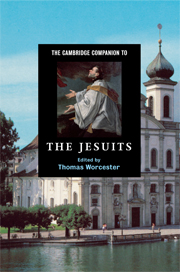Book contents
- Frontmatter
- Introduction
- Part I Ignatius of Loyola
- Part II European Foundations of the Jesuits
- 4 Jesuit Rome and Italy
- 5 The Society of Jesus in the Three Kingdoms
- 6 Jesuit dependence on the French monarchy
- 7 Women Jesuits?
- 8 Jesuits in Poland and eastern Europe
- Part III Geographic and Ethnic Frontiers
- Part IV Arts and Sciences
- Part V Jesuits in the Modern World
- Select bibliography
- Index
8 - Jesuits in Poland and eastern Europe
from Part II - European Foundations of the Jesuits
Published online by Cambridge University Press: 28 September 2008
- Frontmatter
- Introduction
- Part I Ignatius of Loyola
- Part II European Foundations of the Jesuits
- 4 Jesuit Rome and Italy
- 5 The Society of Jesus in the Three Kingdoms
- 6 Jesuit dependence on the French monarchy
- 7 Women Jesuits?
- 8 Jesuits in Poland and eastern Europe
- Part III Geographic and Ethnic Frontiers
- Part IV Arts and Sciences
- Part V Jesuits in the Modern World
- Select bibliography
- Index
Summary
It is hard to believe that at the time when almost all European countries were facing violent religious conflicts Poland welcomed different dissidents in faith. This fact is well known in Polish historiography and is seen as a symbol for Polish tolerance. In fact Poland received Italian Antitrinitarians, German Lutherans, Dutch Mennonites, English Quakers, and Huguenots - all those who were denied religious freedom in their own countries. We might have in mind today's America; nevertheless, it was, as a matter of fact, Catholic Poland, but of the sixteenth century! We have to add that it was a different Poland and a different Catholicism, closer to the England of Henry VIII than to Rome. A good illustration for that is the primate of Poland, Jakob Uchanski, who was not very concerned by the possibility of being put on trial by Pope Paul IV in 1559, and who was justly seen as “a potential head of the Polish national church.” It was also about that Poland that Erasmus of Rotterdam, having many friends there, said Polonia mea est, and his influence on the Polish Reformation and Counter-Reformation is well known. Perhaps also the humanistic education, which Jesuits were propagating, contributed to his popularity. In any case, it was clear that when Cardinal Stanislaw Hosius, one of the most prominent representatives of Counter-Reformation tendencies in the Polish Church, and an active participant at the Council of Trent (1546-63), invited them in the year 1564, his dream was to use Jesuits for fighting against Reformation. At that time Hosius was considered to be one of the candidates for the papacy, mainly because of his rigid position towards the Reformation.
- Type
- Chapter
- Information
- The Cambridge Companion to the Jesuits , pp. 136 - 150Publisher: Cambridge University PressPrint publication year: 2008



